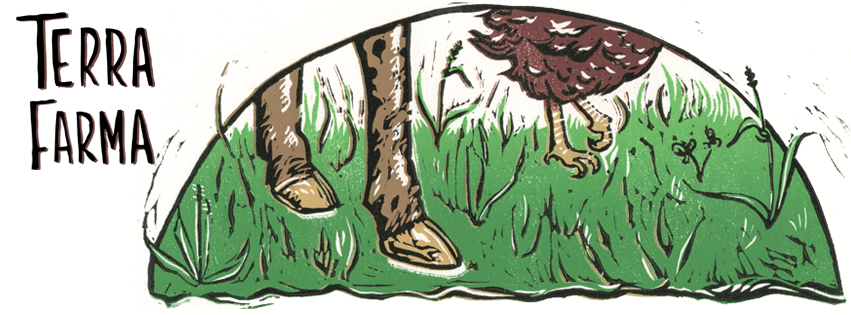In your share
- Whole Chicken
- Sirloin Tip Roast
- Breakfast Sausage
- Lamb stew meat or kebabs (they are the same thing, just labeled differently)
- Jowl Bacon (Guanciale)
- Ground Beef
On the Farm
With on-farm activities still at their winter lull waiting for extended stretches of spring weather to really get the pasture going, this is a great time to shift focus a bit to our work to advocate for common sense agricultural policies at the local, state, and even federal levels.
At the local level, I am using my position on the Board of Directors at East Multnomah Soil & Conservation District to build on our successful Headwaters Incubator Program to create more opportunities for new and underserved farmers and I was recently elected chair of our Land Conservation Committee where I will continue to push for permanent protections of our valuable farmland.
On January 24th I traveled to Salem to testify in person to support House Bill 2616, which would improve consumer access to raw milk by removing the prohibition on retail sales, instituting new safety protocols, and allowing micro-dairies like ours to sell at farmer’s markets and other off-site locations. When we tried to pass something similar about a decade ago, the opposition was fierce from the dairy industry and the bill never made it out of committee. This time, though, there were only two statements in opposition, one from the Farm Bureau and one from the Oregon Health Authority. The Farm Bureau, for some reason, is pinning its opposition on the delivery of raw milk to farmer’s markets and none of their arguments make any sense. This was even pointed out by a committee member from Eastern Oregon. The OHA was just fear-mongering with ancient data from times when refrigeration and modern practices were less common. Feeling a tiny bit optimistic about this one.
Two more bills have hearings this week, and if you are inclined, letters of support to the legislature are important. The first is HB 2998, which would create an Oregon Soil Health program that would provide funding for practices to improve soil quality, water retention, carbon sequestration, and much more. Senate Bill 530 is the big climate bill for this session, and instead of focusing on the likely doomed prospect of curtailing fossil fuels, it instead focuses on the carbon storage potential in every eco-region of the state. It is hoped that we can get bipartisan support for this, and I do have a meeting scheduled with my state senator this week to brief him on it.
I’m following that up with a small group meeting with US Rep Earl Blumenauer on Thursday to talk with him about how to make the federal farm bill work for all of us. He has a long-standing interest in creating good policies related to food and farms and I am so privileged to be invited by him for this session. I’ll provide an update next month on the results of all of these actions.
Recipe – Sirloin Tip Roast, two ways
You get two recipes this month, one if you want something more like a roast beef that you can slice, or, for something more like a pot roast that is more shreddable
Turn over for all the details:
First, for the sliceable roast, recipe from wholesomeyum.com
- 3 lb Sirloin tip roast 1 tbsp Onion powder 2 tsp Dried rosemary
- 2 tbsp Olive oil (divided) 1 tbsp Sea salt 2 tsp Dried thyme
- 1 tbsp Garlic powder 3/4 tsp Black pepper 2 tsp Dried oregano
- Pat the sirloin tip roast dry with paper towels.
- If you have time, place it onto a sheet pan and refrigerate, uncovered, overnight. (This will help form a nice crust when searing, but you can skip this step if you didn’t plan ahead.)
- When ready to cook, remove the roast from the fridge and pat dry again if needed. Tie kitchen twine around the roast at 1-inch intervals. (This will help it keep its shape while roasting.)
- Rub the roast all over with 1 tablespoon of olive oil.
- In a small bowl, combine garlic powder, onion powder, salt, pepper, and dried herbs. Rub the spice mixture all over the meat. Let the meat rest for an hour to come to room temperature.
- Preheat the oven to 250 degrees F (121 degrees C).
- Heat the remaining tablespoon of olive oil in a large cast iron skillet over medium-high heat. Add the roast and sear on all sides, about 3 minutes per side, until browned.
- Transfer the sirloin tip roast to a roasting pan.
- Bake the sirloin tip roast in the oven, until it reaches 115 degrees F for rare (~30-35 minutes), 125 degrees F for medium rare (40-45 minutes), or 135 degrees F for medium (~50-55 minutes).
- Remove from the oven, transfer to a cutting board, cover loosely with aluminum foil, and rest for 15-20 minutes before slicing. (This will seal in the juices and the internal temperature will rise another 10 degrees to reach the right level of doneness.) Slice the meat against the grain to serve.
The pot roast-style is from sundaysuppermovement.com
2.5 lbs chuck roast, rump roast, sirloin tip roast, or English roast
2 yellow onions sliced 2 crushed garlic cloves or 2 teaspoons of minced garlic
2 carrots cut longways 3 cups beef stock
1 cup red wine 2 sprigs thyme or 1 teaspoon dried thyme
1 sprig rosemary 2 tablespoon Worcestershire sauce
1 teaspoon salt 1 teaspoon pepper
1. Preheat oven to 350F. Heat 1 tablespoon of olive oil in a large Dutch Oven over medium to high heat.
2. Sear the roast 2 minutes each side and remove.
3. Add the onion and cook, stirring for 3 minutes, then add the garlic and stir for another 2 minutes.
4. Deglaze the pan by adding in the red wine, and use a wooden spoon to gently scrape the bottom of the pan to release the flavors. Add in the beef stock, carrots, thyme, rosemary, Worcestershire sauce, and salt and pepper, and stir well. Add the roast back into the Dutch oven allowing it to be covered with the liquid.
5. Cover with the lid and place in the oven and roast for approximately 3 hours, or until beef is tender.
6. Remove beef from the Dutch Oven and let it rest for 10-15 minutes on a cutting board.
7. Shred the beef using two forks to pull it apart.
8. Place the Dutch Oven back on the stove, and bring to a slow boil, uncovered to reduce the liquid.
9. If you find it is not reducing, take ½ a tablespoon of cornstarch and mix it with 2 tablespoons of stock in a small cup. Pour it back into the liquid and it should thicken. Serve the beef on mashed potatoes or butter noodles with the sauce on top.

